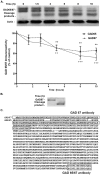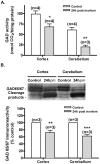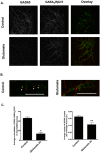Role of the proteasome in excitotoxicity-induced cleavage of glutamic acid decarboxylase in cultured hippocampal neurons
- PMID: 20405034
- PMCID: PMC2853570
- DOI: 10.1371/journal.pone.0010139
Role of the proteasome in excitotoxicity-induced cleavage of glutamic acid decarboxylase in cultured hippocampal neurons
Abstract
Glutamic acid decarboxylase is responsible for synthesizing GABA, the major inhibitory neurotransmitter, and exists in two isoforms--GAD65 and GAD67. The enzyme is cleaved under excitotoxic conditions, but the mechanisms involved and the functional consequences are not fully elucidated. We found that excitotoxic stimulation of cultured hippocampal neurons with glutamate leads to a time-dependent cleavage of GAD65 and GAD67 in the N-terminal region of the proteins, and decrease the corresponding mRNAs. The cleavage of GAD67 was sensitive to the proteasome inhibitors MG132, YU102 and lactacystin, and was also abrogated by the E1 ubiquitin ligase inhibitor UBEI-41. In contrast, MG132 and UBEI-41 were the only inhibitors tested that showed an effect on GAD65 cleavage. Excitotoxic stimulation with glutamate also increased the amount of GAD captured in experiments where ubiquitinated proteins and their binding partners were isolated. However, no evidences were found for direct GADs ubiquitination in cultured hippocampal neurons, and recombinant GAD65 was not cleaved by purified 20S or 26S proteasome preparations. Since calpains, a group of calcium activated proteases, play a key role in GAD65/67 cleavage under excitotoxic conditions the results suggest that GADs are cleaved after ubiquitination and degradation of an unknown binding partner by the proteasome. The characteristic punctate distribution of GAD65 along neurites of differentiated cultured hippocampal neurons was significantly reduced after excitotoxic injury, and the total GAD activity measured in extracts from the cerebellum or cerebral cortex at 24h postmortem (when there is a partial cleavage of GADs) was also decreased. The results show a role of the UPS in the cleavage of GAD65/67 and point out the deregulation of GADs under excitotoxic conditions, which is likely to affect GABAergic neurotransmission. This is the first time that the UPS has been implicated in the events triggered during excitotoxicity and the first molecular target of the UPS affected in this cell death process.
Conflict of interest statement
Figures







Similar articles
-
Excitotoxic stimulation downregulates the ubiquitin-proteasome system through activation of NMDA receptors in cultured hippocampal neurons.Biochim Biophys Acta. 2013 Jan;1832(1):263-74. doi: 10.1016/j.bbadis.2012.10.009. Epub 2012 Oct 13. Biochim Biophys Acta. 2013. PMID: 23069389
-
GABAergic dysfunction in mGlu7 receptor-deficient mice as reflected by decreased levels of glutamic acid decarboxylase 65 and 67kDa and increased reelin proteins in the hippocampus.Brain Res. 2010 Jun 2;1334:12-24. doi: 10.1016/j.brainres.2010.03.078. Epub 2010 Mar 29. Brain Res. 2010. PMID: 20353761
-
Glutamate alteration of glutamic acid decarboxylase (GAD) in GABAergic neurons: the role of cysteine proteases.Exp Neurol. 2008 Sep;213(1):145-53. doi: 10.1016/j.expneurol.2008.05.013. Epub 2008 May 27. Exp Neurol. 2008. PMID: 18599042
-
The regulation of glutamic acid decarboxylases in GABA neurotransmission in the brain.Arch Pharm Res. 2019 Dec;42(12):1031-1039. doi: 10.1007/s12272-019-01196-z. Epub 2019 Nov 30. Arch Pharm Res. 2019. PMID: 31786745 Review.
-
Role of the ubiquitin-proteasome system in brain ischemia: friend or foe?Prog Neurobiol. 2014 Jan;112:50-69. doi: 10.1016/j.pneurobio.2013.10.003. Epub 2013 Oct 22. Prog Neurobiol. 2014. PMID: 24157661 Review.
Cited by
-
Synaptogenesis Stimulates a Proteasome-Mediated Ribosome Reduction in Axons.Cell Rep. 2019 Jul 23;28(4):864-876.e6. doi: 10.1016/j.celrep.2019.06.080. Cell Rep. 2019. PMID: 31340150 Free PMC article.
-
Extrasynaptic N-methyl-D-aspartate (NMDA) receptor stimulation induces cytoplasmic translocation of the CDKL5 kinase and its proteasomal degradation.J Biol Chem. 2011 Oct 21;286(42):36550-8. doi: 10.1074/jbc.M111.235630. Epub 2011 Aug 5. J Biol Chem. 2011. PMID: 21832092 Free PMC article.
-
The blood brain barrier and the role of ratiometric molecular analysis in schizophrenia.Psychiatry (Edgmont). 2010 Dec;7(12):20-3. Psychiatry (Edgmont). 2010. PMID: 21274392 Free PMC article.
-
Downregulation of GABAA Receptor Recycling Mediated by HAP1 Contributes to Neuronal Death in In Vitro Brain Ischemia.Mol Neurobiol. 2017 Jan;54(1):45-57. doi: 10.1007/s12035-015-9661-9. Epub 2016 Jan 5. Mol Neurobiol. 2017. PMID: 26732589
-
Mesenchymal stem cells secretome-induced axonal outgrowth is mediated by BDNF.Sci Rep. 2017 Jun 23;7(1):4153. doi: 10.1038/s41598-017-03592-1. Sci Rep. 2017. PMID: 28646200 Free PMC article.
References
-
- Lipton SA, Rosenberg PA. Excitatory amino acids as a final common pathway for neurologic disorders. N Engl J Med. 1994;330:613–622. - PubMed
-
- Choi DW. Glutamate neurotoxicity and diseases of the nervous system, Neuron. 1988;1:623–634. - PubMed
-
- Gardoni F, Di Luca M. New targets for pharmacological intervention in the glutamatergic synapse. Eur J Pharmacol. 2006;545 (2006):2–10. - PubMed
-
- Lewen A, Li GL, Olsson Y, Hillered L. Changes in microtubule-associated protein 2 and amyloid precursor protein immunoreactivity following traumatic brain injury in rat: influence of MK-801 treatment. Brain Res. 1996;719:161–171. - PubMed
-
- Carvalho AP, Ferreira IL, Carvalho AL, Duarte CB. Glutamate receptor modulation of [3H]GABA release and intracellular calcium in chick retina cells. Ann N Y Acad Sci. 1995;757:439–456. - PubMed
Publication types
MeSH terms
Substances
LinkOut - more resources
Full Text Sources

